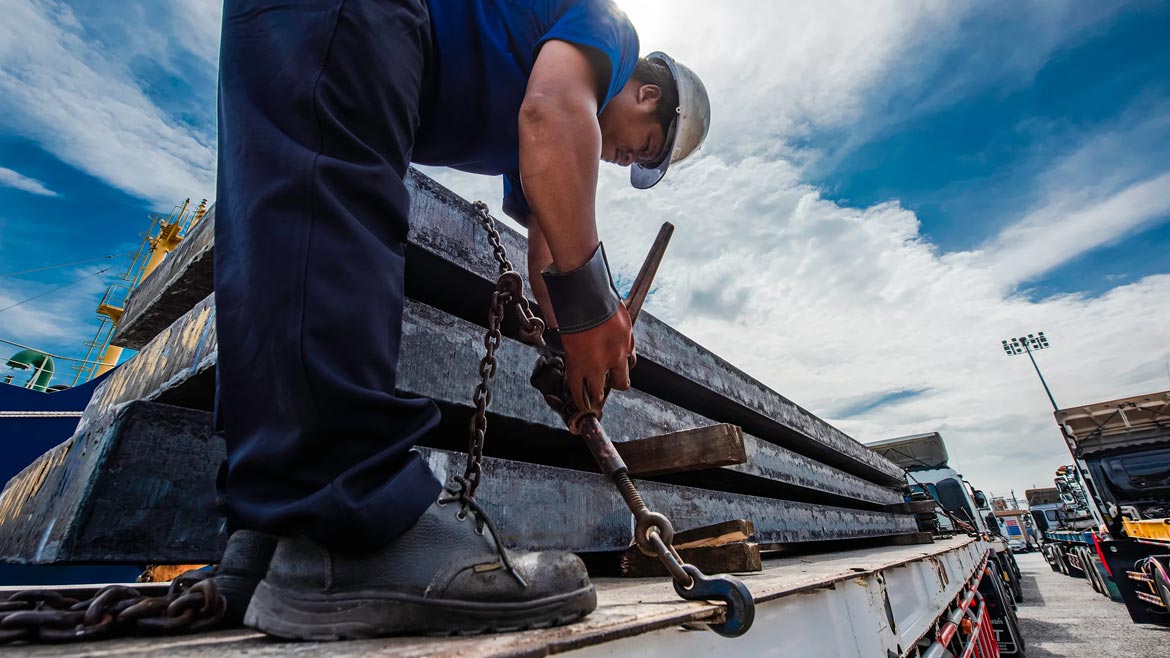When you are driving down the highway and notice a semi hauling a flatbed with cargo, do you ever think to yourself “how does that not fall off?” or “what’s really keeping that cargo in place?” I know I have asked these questions to myself from time to time on the road with my family; after all, safety on the roads impacts everyone.
Commercial motor vehicles have a strict obligation to comply with several federal regulations to ensure that our roadways are safe for travelers. The Federal Motor Carrier Safety Administration (FMCSA regulation subpart 392.9) requires commercial vehicle drivers to inspect and properly secure all cargo before starting and operating their vehicles.
In addition, drivers must:
- Inspect cargo within the first fifty miles of their route/trip to verify that nothing has shifted or become loose; and
- Reexamine cargo when making a change of duty status; or the vehicle has been in operation for three hours; or has been in motion for 150 miles; whichever occurs first.
An unofficial rule to load securement is also that the driver is the captain of their own ship and is ultimately responsible for the safety of themselves and those around them. FMCSA regulation subparts 393.100-393.136 provide specific details on the types and minimum requirements for tie downs allowed and rules for securing cargo such as pipe, steel, heavy equipment, etc.
The consequences for not following FMCSA and DOT regulations can be costly to operators and companies due to the number of accidents that may occur. The benefits of proper cargo securement and training are of the utmost importance for all drivers operating a vehicle on the roadways.
So, what does this all mean? Let’s break it down to the basics for flatbed cargo securement to help simplify and refresh what some of you may already be aware of.
The consequences for not following FMCSA and DOT regulations can be costly to operators and companies due to the number of accidents that may occur. The benefits of proper cargo securement and training are of the utmost importance for all drivers operating a vehicle on the roadways.
THE BASICS OF CARGO SECUREMENT:
Ensure the equipment being used to tiedown and secure cargo is properly rated. With the help of these ratings, you will know the overall strength, break strength, and working load limit (WLL);
- Check all ratchet straps regularly for general damage, wear and tear;
- It is highly recommended that you use a minimum of two tie down straps even if one is sufficient for the cargo when applicable;
- All cargo and dunnage must be firmly tied down, secured, and balanced to a flatbed trailer;
- If a trailer is enclosed this does not ensure the load inside is always safe, additional securement, and security is always important and recommended;
- Vibrations and wind on the road can make tiedown straps loosen. Hence it is necessary to inspect thoroughly throughout the trip for security; and
- If the height of the cargo is taller than the vehicle, extra securement is needed for safety against wind resistance and ensure route for height restrictions.
COMMON LOAD SECUREMENT VIOLATIONS TO AVOID:
- Lack of sufficient number of tie downs;
- Use of damaged tie downs;
- Failure to secure cargo and dunnage; and
- Use of loose or inadequate tie downs
These general rules applicable to vehicles can be found on The Occupational Safety and Health (OSHA) website under part number 1917 subpart C for cargo handling gear and equipment. Along with current totals of crashes, injuries, fatalities and acute/non-acute violations on The Federal Motor Carrier Safety Administration (FMCSA) website.
In 2021 The Federal Motor Carrier Safety Administration (FMCSA) reported 180,316 total crashes, 5,414 total fatalities and a total of 89,313 injuries involving both large trucks and buses. There were 1,368,270 inspections performed with 4,976 Acute/Critical violations, and 30,543 Non-Acute/Non-Critical violations also reported for both large trucks and buses in 2021 alone. These are truly eye-opening numbers for not only the safety aspect, but for the public. These totals and more information can be seen on The Federal Motor Carrier Safety Administrations website.
Always remember that it is very important to a have the correct and sufficient tie down equipment for your load/cargo. According to FMCSA in terms of aggregate working load limit, the equipment used for load securement must be at least half of the weight of the cargo. Depending upon the weight load limit, make sure to use the sufficient number of tiedown equipment required (more if applicable).
Also remember, these mistakes can be avoided by proper inspection of equipment and keeping securement methods in top working condition. Report or replace all equipment deemed unsafe for safe load securement methods. Precautions are in place so the cargo and everyone on the roadways always remain safe. Leave no room for the question “how does that not fall off?”





